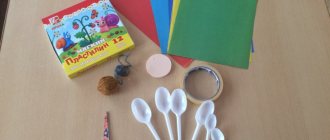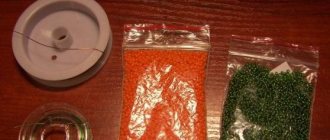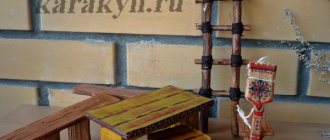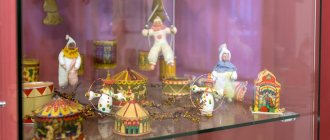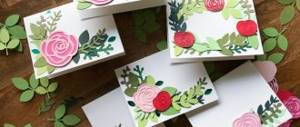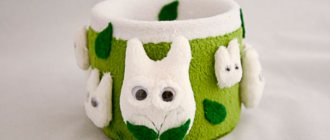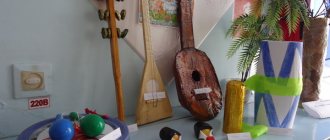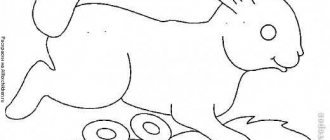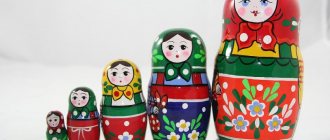“Theater for kids. Scarf dolls"
Mikhailova Ekaterina Nikolaevna teacher, kindergarten No. 1, Kolpinsky district, St. Petersburg
Advertising message
“Theater for kids. Scarf dolls" educational and creative project in the first junior group
Project name: Shawl Theater;
Type of project: educational-creative, role-playing;
Project duration: long-term;
Author and participants of the project : Educator-Mikhailova E.N., children 2-3 years old, parents of pupils;
Project goal : Development of the child’s personal qualities, his creativity through joint theatrical activities with adults;
Relevance:
A full-fledged education of a child of primary preschool age is possible only if the child is psychologically comfortable in the process of communicating with peers, adults in kindergarten and family.
When a child enters kindergarten, it becomes stressful. Adaptation is difficult, with a lot of negative changes in the child’s body, which is manifested in the child’s behavior. When a child enters kindergarten, an adaptation period begins not only for him, but also for his parents.
The situation of protracted adaptation of children and parents to the conditions of preschool educational institutions does not contribute to the full development of children. Therefore, there is a need to facilitate the adaptation period. This can be done by achieving emotional comfort for children and involving parents in the educational process through joint theatrical activities with children. Therefore, it becomes especially important to create conditions for theatrical activities on the territory of the kindergarten.
One of the most effective means of developing and educating a child in early preschool age is theater and theatrical games.
Play is the leading activity of preschool children, and theater is one of the most democratic and accessible forms of art, which allows solving many pressing problems of pedagogy and psychology related to artistic and moral education, the development of personal communicative qualities, the development of imagination, fantasy, initiative and etc.
Theatrical activity is a source of development of feelings, deep experiences of the child, and introduces him to spiritual values. They develop the child’s emotional sphere, make him sympathize with the characters, and, in addition, allow him to develop the experience of social behavior skills due to the fact that every literary work or fairy tale for preschool children always has a moral orientation.
In the process of theatrical play, the child’s vocabulary is activated, the sound culture of his speech and its intonation structure are improved, which is very important at this age. The role played and the spoken lines put the child in front of the need to express himself clearly, distinctly, and intelligibly. His dialogic speech and its grammatical structure improve.
I wanted to bring a fresh twist to my work, to create a doll that would help solve all pedagogical problems.
Scarf dolls are bright and spectacular and are a real decoration for theatrical productions and children's leisure time, as a surprise moment in any activity.
Scarf dolls enrich children with vivid impressions, develop creativity, memory, thinking, speech, imagination, attention, and also expand children's horizons. By playing with these dolls, children become proactive and sociable.
Project objectives:
1. To introduce children to the diverse puppet world of childhood, to arouse children’s interest in the puppets of the scarf theater;
- Stimulate the activity and creativity of children in creating various images, using them in various activities;
3.Create “ child-adult ” society on the principles of partnership, cooperation, dialogue;
- Teach parents the means and methods of interaction with the child in the process of theatrical activities;
- Enrich parent-child relationships when holding joint theatrical events using scarf dolls;
Integration of educational areas:
"Social and communicative development
- Active inclusion of children in theatrical activities within the framework of educational activities, in joint and independent activities;
- Develop the ability to perform actions in accordance with the game rules;
- Cultivate emotional responsiveness;
"Cognitive Development"
To form ideas about the world around us, broaden the horizons of children through the scarf theater;
Stimulate play actions that correspond to the text of familiar fairy tales, songs, nursery rhymes;
"Speech development"
Communication activities
- Develop and enrich children's active vocabulary through nouns denoting objects of the surrounding world, verbs denoting the actions of animals;
- Encourage the child to repeat after the adult individual words and expressions from poems, nursery rhymes, and fairy tales;
Reading fiction
- Develop emotional responsiveness to works of literature, arouse interest in them;
- Form a holistic picture of the world by reading children's fiction;
- Develop the ability to listen carefully to a work and answer questions about its content;
"Artistic and aesthetic development"
Productive activity
- Develop an aesthetic perception of the image of animals and the ability to convey what they see in drawings and crafts;
Musical activities
- Maintain interest in joint musical and rhythmic games using scarf dolls;
- To develop the skill of more accurately performing dance movements that convey the character of the depicted dolls;
"Physical development»
- Accumulate and enrich the motor experience of children through active, round dance games, entertainment with parents;
- Learn to perform movements in accordance with the text;
- Develop fine motor skills of the hands: coordination of movements, relieving muscle tension;
Expected Result:
- Favorable adaptation of children to preschool educational institutions;
- Establishing partnerships between participants in the educational process in preschool educational institutions;
- Equipping the theater corner with “Living Hand” dolls
Forms of joint activities:
- Puppet shows;
- Sketch games with scarf dolls;
- Fun games with scarf dolls;
- Outdoor games;
- Dramatization of fairy tale episodes;
- Finger gymnastics, articulation gymnastics;
- Evenings of entertainment with the participation of parents;
- Story games with scarf dolls;
Project products – Shawl Puppet Theater;
Final event : Theatrical entertainment with parents “Zayushkina’s hut”
Project implementation stages
- Preparatory;
- Basic;
- Final.
Preparatory stage:
- Monitoring children's creative abilities, their skills and abilities by observation, games with various types of theater;
- Development of a project passport: defining the goals and objectives of the project, developing leisure scenarios, puppet shows together with parents, updating card files of games to develop the emotional sphere and imagination of children;
- Drawing up a long-term plan for theatrical activities, taking into account the age characteristics of children;
- Individual conversations, consultations with parents to identify their interest in replenishing the theater corner, their abilities in one or another area of handicrafts and opportunities;
Main stage:
- Creation of a developmental environment for theatrical activities
- Visual information for parents: “Theater at Home” consultations,
“Scarf Theater” “Do-it-yourself Scarf Theater”, booklets
“The Kid and the Fairy Tale”, “The Magical World of Theater”;
- Organization of a morning reception for children: dressing up in costumes of various fairy tale characters; meeting of children with the heroes of fairy tales of the scarf theater;
- Development of gaming skills through theatrical activities: role-playing games, simulation games, didactic games, outdoor games, finger, articulation gymnastics, GCD;
- Involving parents in the family club “Fairy Tale with Mom”: organizing theatrical performances, evenings of leisure for children with the participation of parents, conducting theater workshops on making scarf dolls, theatrical competitions “Scarf doll with mother’s hands”, “Dress for...”, theater lounges “We play” to the theatre";
The final stage:
- Exhibition of works by parents: “Fairy Tale Workshop”;
- Open screening of the fairy tale “Zayushkina’s Hut” with the participation of parents in the leading roles;
- Creation of a photo gallery and video blog “Theater Living Room” on the website of the “smile” group;
- Creation of the photo album “Scarf Theater”
- Project presentation;
Project results:
For children
- Children adapt to the conditions of preschool educational institutions;
- Enriching impressions, creating a positive emotional mood while playing with a theatrical doll;
- Formation (adequate to the age of children) of ideas about the diversity of dolls;
- Replenishing the theater corner with attributes of fairy tales and characters from the scarf theater;
- In independent activities, children improvise with the characters of the scarf theater;
For parents
- Bringing parents closer to each other and the teacher in the process of making a scarf doll;
- Enrichment of parent-child relationships in the process of joint theatrical activities;
The main principles in organizing work on the use of scarf dolls in children’s lives are:
- Accounting for the primary (play) activity of a preschooler;
- A combination of realism and imagination;
- The relationship of all participants in the creative educational development process;
Ways to use scarf dolls in different activities:
- Surprise moment in GCD;
- Organization of routine moments in the group;
- Organization of leisure activities and performances for children;
- Organization of role-playing games;
- The use of scarf dolls in work and independent activities;
- Using a doll on a walk, excursion;
Algorithm for using scarf dolls with young children
- Surprise use of a scarf doll
- Acting out a scarf doll (improvisation)
- Plot-play activities (dramatizations with a scarf doll)
- Using emotional, imitation and play exercises to develop the expressive image of a scarf doll.
- The use of scarf dolls in theatrical activities.
Long-term plan for working with parents for 2019–2020.
| month | Activities and forms of work |
| September | Development of an event plan for the year Questioning parents “Theater and Children” |
| October | Presentation for parents “The Magical World of Theater” Joint leisure time with parents “Walk in the autumn forest” (using a scarf doll – Autumn) Theater workshop “Felt Finger Theater” for the didactic scarf doll Funnily Grandmothers |
| november | Theater workshop “Scarf doll Bunny” (Children work together with their parents in selecting materials for a hare costume and making carrot attributes for a scarf doll) Open lesson on speech development “Visiting the Bunny” Fun game “Let’s treat the Bunny with a carrot” |
| December | Theater workshop "Grandma's Tales" (Making a finger theater for a didactic scarf doll) Puppet theater with the participation of parents “Forest New Year” Master class "Children's Scarf Theater" |
| January | Leisure time with parents “In Grandma’s Yard” Mini-project “Fairy Tale with Mom” Leisure time with parents “Visiting the Snowman” (fox, bunny characters from the scarf theater) Theater lounge “Making scarf dolls for the fairy tale Zayushkin’s Hut” (rooster, fox, dog, bear) |
| February | Competition “Sundress for Matryoshka” Theater lounge “Making a scarf doll - Matryoshka” for the holiday of March 8 Puppet show "Teremok" |
| March | Leisure “Visiting Matryoshka” |
| April | Theatrical leisure "Zayushkina hut" |
| May | Leisure time with parents “Visiting the sun” |
Bibliography:
1. Theater of dolls and toys in kindergarten: puppet shows, variety miniatures for children 2-7 years old / comp. O.P. Vlasenko.-Volgograd: Teacher, 2009
2. Kartushina M.Yu. Communicative games for preschoolers: Methodological manual.-M: Publishing house "Scriptorium 2003", 2013
Partner promotions
Do-it-yourself puppet theater with clothespins for children
Master Class.
“Theater on clothespins. Piglet Naf-naf.” Author
:
Evgenia Arkadyevna Kilina, teacher of the speech therapy group at MDOAU kindergarten No. 10, the city of Neftekamsk, Republic of Bashkortostan. The master class is intended for educators and parents.
Goal
:
To interest and encourage creative people to make theatrical dolls, with their subsequent use in theatrical activities of preschool children. Objectives:
• To arouse interest in theatrical and gaming activities.
• Introduce the technology of making a theatrical puppet using a wooden clothespin. • Development of creativity and imagination. "Magic land!" - this is what the great Russian poet A.S. Pushkin once called the theater. The feelings of the great poet are shared by both adults and children who have come into contact with this amazing form of art. A special role belongs to the theater in solving problems related to the upbringing and development of a preschool child. Through theatrical and playful creativity, we can develop children’s emotional responsiveness, intellectuality, and develop children’s communication skills, artistry, and speech activity. In the daily life of a kindergarten, teachers use various types of theaters: bibabo, finger, tabletop, planar (flannelgraph or magnetic board), puppet, book theater, mask theater, etc. I want to tell and show how to make an unusual theater on clothespins . Step-by-step work process. Necessary materials and tools:
• Wooden clothespin; • Scissors; • Cardboard; • White sheet of paper; • Self-adhesive colored paper; • Acrylic paints and brush; • Glue (“Moment” or “Universal”); • Clothesline • Beads; • A simple pencil. • Ribbon for bow.
Step-by-step work process
1. On a sheet of paper, draw a sketch of the future theatrical pig puppet. (photo 2)
2. We cut out parts of the model (head, snout and legs) and trace them along the contour on self-adhesive paper. The piglet's head is light pink, his snout is bright pink, and his legs are black. (Photo 3)
3.Cut out the pieces with scissors, glue them onto cardboard and cut them out again. (Photo 4)
4.On the pig’s face we glue the eyes, nostrils, and mouth from black self-adhesive paper. (Photo 5)
5. Using acrylic paints and a brush, paint the surface of the clothespin pink. (Photo 6)
6. Take a clothesline about 10 cm long. We string beads onto it from both ends and secure them with glue. We got hands. (Photo 7)
7.Glue the head, arms and legs to the clothespin with glue. (Photo 8,9)
8. The tail is made of paper, twisted into a wire shape and painted with acrylic paint. (Photo 10)
9. The pig’s tail reminds us of a spring, and we achieve this by winding it around the rod of the handle. (Photo 11)
10. Glue the tail into the clip of the clothespin. During drying, you should keep the clothespin open with a spacer inserted into it, otherwise its parts can easily stick to each other. 11. We tie a green ribbon-bow around the piglet’s neck. Our pig Naf-naf is ready. (Photo 12)
The technology for making dolls on clothespins is very simple; anyone can master it. The creation process is very simple and fun. Go for it! Let new fairy-tale heroes be born in your hands, which your children will definitely love. And in my hands these funny little animals were born and now live in the theater corner. (Photo 13)
We recommend watching:
DIY stomp dolls DIY paper hare. Master class with step-by-step photos Crocheted puppet theater. Teremok Puppet show for elementary school
Similar articles:
DIY puppet theater. Master Class
DIY puppet theater
An extracurricular event for schoolchildren to combat bad habits. Drug trial
